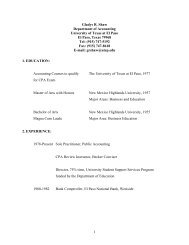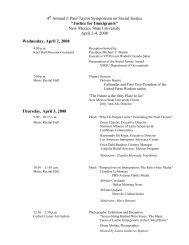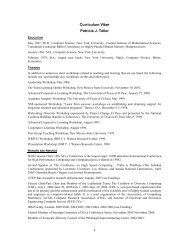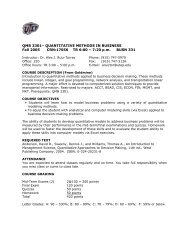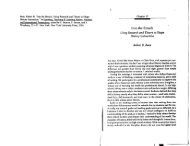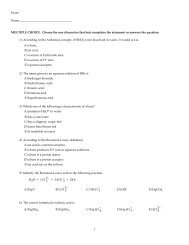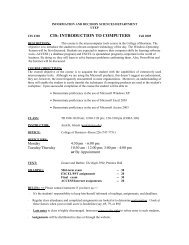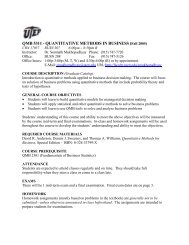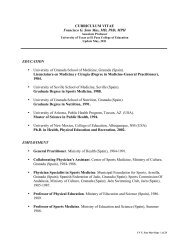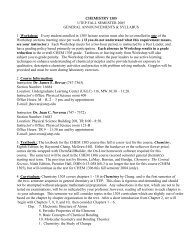Stanford-Binet Intelligence Scales, Fifth Edition ... - Faculty.utep.edu
Stanford-Binet Intelligence Scales, Fifth Edition ... - Faculty.utep.edu
Stanford-Binet Intelligence Scales, Fifth Edition ... - Faculty.utep.edu
Create successful ePaper yourself
Turn your PDF publications into a flip-book with our unique Google optimized e-Paper software.
<strong>Stanford</strong> -<strong>Binet</strong> <strong>Intelligence</strong> <strong>Scales</strong>, <strong>Fifth</strong> <strong>Edition</strong> [233]tinlinlmarly19hubrchart,theDnsrchgermdthe.tesererdmmelon:hre:edUy,toeu:d;ed:st;90ofla~senn-hetal .,ed~r.10, of the Wechsler Preschool and Primary Scale of<strong>Intelligence</strong>-Revised (WPPSI-R) (r == .83); theWechsler <strong>Intelligence</strong> Scale for Children-Third<strong>Edition</strong> (WISC-III) (r:: .84); the Wechsler Adult<strong>Intelligence</strong> Scale-Third <strong>Edition</strong> (WAIS-III) (r:: .82); and the vVoodcock-Johnson III Tests ofCognitive Abilities (r .78).Next, t~e SB5 technical manual presents aseries of stuclies that compare the instrument withtests of academic achievement. Two studies arepresented that compare the SB5 vvith the Woodcock-JohnsonIII Tests of Achievement and theWechsler Individual Achievement Test-II. Theresulting pattern of correlations is quite variedwith coefficients ranging from .33 to .84. Dependingupon the pragmatic orientation of the user,these correlations will either support or not supportthe utilization of the instrument. If, for example,the SB5 (and most other commerciallyavailable IQtests) is perceived as a predictor ofschool success, then the SB5-Achievement correlationswill be seen quite favorably. The SB5 isclearly highly correlated with tests of academicachievement and users of the SB5 will be able tomake accurate predictions about the academicperformance ofstudents who complete the test. Incontrast, users of the SB5 who are instead lookingfot a measure of "pure" intelligence will interpretmany of the correlations with achievement as"too high" (e.g., SB5-WJ III Reading Comprehension,r :: .84; SB5-WJ III Math Reasoning,r = .80; SB5-WIAT-II Math, r =.79)and will argue that the SB5 is too heavily achievement-loaded.With correlations in the .80 range,approximately two-thirds of the informationcontained on the SB5 and tests of academicachievement reflects shared variance or overlappingcontent, a figure that. may be too high forinstruments thought to be measuring related yetdiscrete constructs.Finally, a series of studies is described insupport of the construct validity of the SB5, AI ...though the SB4 was based on a four-factor model,the SB5 was constructed on a five-factor hierarchicalmodel. All SB5 subtests, across all ages,demonstrated average principal component loadingsofgreater than :70 on the g, or general factor,indicating that each subtest was a good measure ofg. The proportion of SB5 variance accounted forby the g factor ranged from 56% to 61%, dependingon the factoring method. These percentagesare slightly higher than found on the SB4 but arecomparable for other current IQtests.Conftrmatory (CFA) analyses were also performedin an attempt to provide further supportfor the construct validity ofthe SB5. The technicalmanual indicates that a CFA, conducted on fiveage groups from the SB5 normative sample, examinedone- through five-factor models and indicatedthat the ftve-factor model yielded the best fttwhen compared to other models in the analysis. Inexamining these results it is important to note thatin order for the CFA analysis to be performed, thetest author were forced to split each subtest in halfso that 20 variables could be analyzed. Withoutthis adaptation, the test author did not have anidentified modeL Additionally, the CFA ftt statisticspresented in the technical manual are not asgood as would be desired according to some measurementstandards (Hu & Bentler, 1998, 1999).Finally, it is unclear why a hierarchical model wasexplicitly hypothesized yet a hierarchical modelCFA was not performed.To their credit, the developers of the SB5attempted to provide an empirically supportedmethod for interpretive analyses. The presentationofthe two-stage clustering technique contained inthe interpretive manual provides users with 10core profiles identified in the SB5 standardizationsample. These patterns of subtest profiles allowusers a normative comparison from which interpretivehypotheses can be generated, in contrast toa purely speculative "armchair" approach that looksat an individual's pattern of subtest strengths andweaknesses in isolation. Additional informationabout the cluster analysis, however, would assistusers in the development of more accurate interpretations.Specifically, additional justificationcould be provided as to why a two-stage ratherthan a three-stage analysis was performed(McDermott, 1998). Additionally, it is not clear(a) why an average linkage method was utilizedinstead of Ward's technique; (b) why only onestopping rule (profiles identifjring less than 5% ofthe population were dropped) rather than multiplestopping rules was employed; (c) how many caseswere relocated in the second stage of the analysis;and (d) what standard deviatio,n values correspondto the 10 identified core proftles. Future researchshould address these questions as well as examinethe stability and utility of these profiles in bothregular and exceptional populations.983




